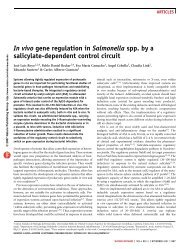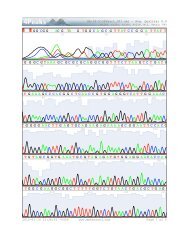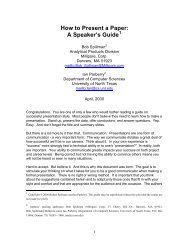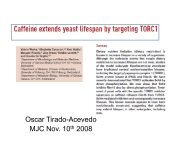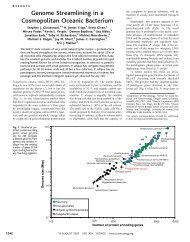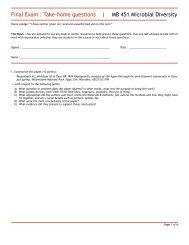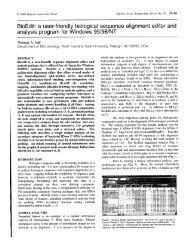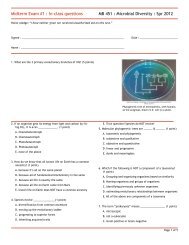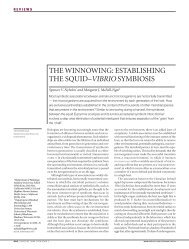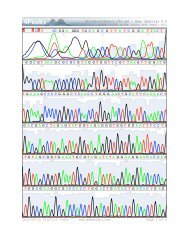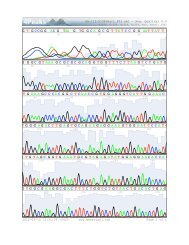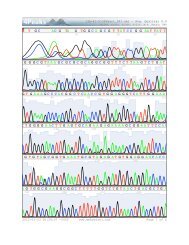Schedule and Program - North Carolina Academy of Science
Schedule and Program - North Carolina Academy of Science
Schedule and Program - North Carolina Academy of Science
Create successful ePaper yourself
Turn your PDF publications into a flip-book with our unique Google optimized e-Paper software.
Assessment <strong>of</strong> Secondary Ecosystem Succession in Hoke County, <strong>North</strong><strong>Carolina</strong>.Zachary Barthel*, Caleb Sutton, Doshie Smith, Leon Jernigan, <strong>and</strong> Ryan EmanuelUniversity <strong>of</strong> <strong>North</strong> <strong>Carolina</strong> at Pembroke <strong>and</strong> NCSUTo assess ecosystem succession in the coastal plain region <strong>of</strong> <strong>North</strong> <strong>Carolina</strong> we used Lidar remote sensingcombined with ground-based measurements. Our site was located on private property in Hoke County, NC.In 2010, a total <strong>of</strong> 14 permanent 20x20-m Plots were established throughout three st<strong>and</strong> types: pine, pineplantation, <strong>and</strong> deciduous wetl<strong>and</strong>s. Age <strong>and</strong> height <strong>of</strong> the three largest trees in each plot were determined usingan increment borer <strong>and</strong> hypsometer, respectively. Trees were identified to species <strong>and</strong> the diameter at breastheight was measured, using a diameter tape, for species with a diameter > 5 cm. To learn about the productivitywithin st<strong>and</strong>s, leaf area index (LAI) was measured using a LAI 2000 plant canopy analyzer. These measurementsin combination with lidar-based st<strong>and</strong> characteristics <strong>of</strong>fer an insight into how secondary succession progressesin the coastal plain. Results show that the deciduous wetl<strong>and</strong> st<strong>and</strong>s have greater species richness than the pine<strong>and</strong> pine plantation st<strong>and</strong>s. This may be the result <strong>of</strong> moisture differences or suppression <strong>of</strong> hardwood invasionin the pine <strong>and</strong> pine plantation st<strong>and</strong>s due to the regular burning <strong>and</strong> pine straw harvesting. Older st<strong>and</strong>s in thepine <strong>and</strong> the deciduous wetl<strong>and</strong> forests had a greater total basal area than the younger st<strong>and</strong>s. Data suggests thatsecondary succession in the forests <strong>of</strong> this region vary according to topography <strong>and</strong> local management practices.The data from this study can be combined with data from the mountains <strong>and</strong> the piedmont to obtain a picture <strong>of</strong>succession throughout the state.The role <strong>of</strong> head shape evolution in an adaptive radiation <strong>of</strong> salam<strong>and</strong>ersDavid A. Beamer <strong>and</strong> Trip LambNash Community CollegeMicrohabitat partitioning amongst Desmognathus species involves a size component, with very large speciesbeing aquatic <strong>and</strong> small species being terrestrial. However the mid-sized species range from aquatic to terrestrial<strong>and</strong> some species demonstrate microhabitat shifts in different portions <strong>of</strong> their range or when they are foundsympatrically with congeners. I investigated head shape with size independent geometric morphometrictechniques. A MANOVA <strong>of</strong> head shape variables found highly significant differences between populationsoccupying different microhabitats. Discriminant analysis was able to correctly classify microhabitat based on thehead shape variables 64% <strong>of</strong> the time. These results suggest that head shape is correlated with microhabitat. Sincelineages do not represent independent data points I used independent contrasts to control for phylogeny <strong>and</strong>found a significant correlation between three <strong>of</strong> the head shape variables <strong>and</strong> microhabitat.Campbell University - 33




